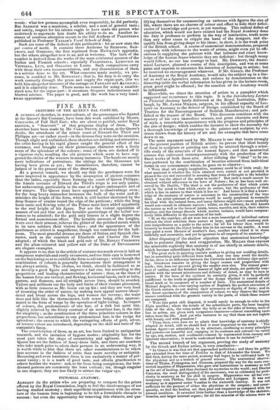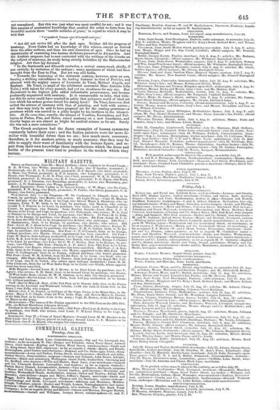PICTORIAL ANATOMY.
ALREADY do the artists who are preparing to compete for the prizes offered by the Royal Commission, begin to feel the disadvantages of not having studied anatomy ; their superficial acquaintance with the struc- ture of the human form is beginning to be felt a formidable obstacle to success : but even the opportunity for removing this obstacle, and qua-
lifying themselves for commencing on cartoons with figures the size of life, where there are no charms of colour and effect to hide their defici- encies of knowledge and power, is yet wanting. This radical defect of education, which would not have existed had the Royal Academy done the duty it professes to perform in the way of instruction, tends more than any other cause to cripple the hand of the designer, and dis- qualify him from giving shape to his ideas; in short, it is the weak point of the British school. A course of anatomical demonstrations, prepared expressly with reference to the wants of artists, might even yet be effi- cacious in supplying the painters with that intimate and exact know- ledge of the human frame wherein they are deficient : but though many would follow, no one has courage to lead. Mr. DEurso'rr, the Anato- mical Lecturer, planned a course of this description, and was at some pains and expense to announce his intention of lecturing to artists; but he received no encouragement whatever. If Mr. GREEN, the Professor of Anatomy at the Royal Academy, would take the subject up in a lite- ral as well as a figurative sense, and enforce by demonstration on the dissecting-table the verbal information he has given in the lecture-room, great good might be effected ; for the sanction of the Academy would be influential.
Meanwhile, we direct the attention of artists to a pamphlet which suggested our recurrence to this topic. It is the Introductory Lecture on Pictorial Anatomy lately delivered at the Royal Institution, Edin- burgh, by Mr. JAMES MILLER, surgeon, in his official capacity of Lec- turer on Anatomy to the School of Design established by the Board of Trustees for the Encouragement of Scottish Manufactures; and pub- lished at the request of the Board. This discourse combines with the mastery of his own immediate science, and great clearness and force of style, a remarkable acquaintance with the progress and principles of the arts of design ; which enables the lecturer to show the necessity for a thorough knowledge of anatomy to the painter and sculptor, by evi- dence drawn from the history of art and the examples that have come down to us.
The main argument used by Mr. MiT.i.ru is one that bears strongly on the present position of British artists: he proves that ideal beauty of form in sculpture or painting can only be attained through a scien- tific study of the structure of the human figure ; and that anatomical science was cultivated contemporaneously with the production of the finest works of both these arts. After defining the " ideal " to be na- ture perfected by the combination of beauties selected from individual forms in one consummate whole, he goes on to observe-
" Were ideal art simply imaginative, anatomy could be of little avail; for what mattered it whether the form attained were correct or not provided it pleased the eye and succeeded in arousing that train of thought in the beholder which it was the object of the artist to excite ? But such a result cannot be obtained without adherence to the laws of Nature; for, as has been well ob- served by Mr. Hazliit, The ideal is not the preference of that which exists only in the mind to that which exists in nature, but the preference of that which is fine in nature to that which is less so.' And hence it is that a know- ledge of ths anatomy of nature is necessary to the construction of the true ideal. An artist ignorant of anatomy would be sorely perplexed to reconcile his ideal with the natural form, and many failures might not—most probably would not—result in ultimate success ; whilst, on the contrary, he who knows the nature as well as the form of joints, bones, muscles, and skin, their relative position, and the change therein which motion induces, would have compara- tively little difficulty in the execution of his task. "If, on the contrary, all art were but a mere transcript of individual nature without the ideal selection from nature at large, again would anatomy sink into insignificance as a guide to the artist ; for all his labour then would be leisurely to transfer the object before him to his canvass or the marble. A man may paint a mere likeness of another's face, another may chisel it in stone faithfully and accurately, and yet be ignorant in all respects of its anatomy."
After disposing of the shallow objection that anatomical knowledge leads to pedantic display and exaggeration, Mr. Mri.r.zu thus exposes the miserable sophistry that anatomy is of use chiefly in minute details, which become subordinate in high art-
" The great style in painting consists neither in giving nor avoiding details, hut in something quite different from both. Any one may avoid the details. So far, there is no difference between the Cartoons and an ordinary sign-paint- ing. Greatness consists in giving the larger masses and proportions with truth ; this does not prevent giving the smaller ones also. The utmost gran- deur of outline, and the broadest masses of light and shade, are perfectly com- patible with the utmost minuteness and delicacy of detail, as may be seen in nature. If the form of the eyebrow be correctly given, it will be perfectly indifferent to the truth or grandeur of the design whether it consist of one broad mark or be composed of a number of lines. The anatomical details of Michael Angelo, the ever-varying outline of Raphael, the perfect execution of the Greek statues, do not destroy their symmetry or dignity of form ; and in the finest specimens of the composition of colour, we may observe the largest masses combined with the greatest variety in the parts, of which those masses are composed. "Were this point still disputed, it would surely be enough to refer to the Elgin marbles ; where the details of the subordinate parts, the loose hanging folds of the skin, the veins under the belly or on the sides of horses, more or less in action, are given with scrupulous exactness—almost resembling casts taken from the life. And yet who ventures to say that those are not replete with beauty and with grandeur? " Thus, then, even were we to admit that knowledge of anatomy is chiefly adapted to detail, still we should find it most important to the artist. The human figure—so astonishing in its structure, combining so many principles and powers—so beautiful and engaging in its contours and colours—so varied by age, sex, motion, and sentiment—cannot be represented from cursory and ignorant observation; it must be understood before it can be imit”frd '"
The second branch of his argument, proving the study of anatomy by the Greek and Italian artists, is very conclusive-
" In Greece it was that art first approached perfection ; and there its golden age extended from the time of Pericles to that of Alexander the Great. We find that, during the same period, anatomy bad begun to be cultivated both by the physician and as a branch of general science. The anatomical observa- tions of Thales, Pythagoras, and Alcmeon, prepared the way for the more con- nected inquiries of Hippocrates, who gave oral instructions in anatomy as well as the art of healing, and thus disclosed its mysteries to the world ; and Diode!' Carystus, the most distinguished of his successors, was as celebrated for profi- ciency in anatomy as for his skill in surgery. Hippocrates was all but con- temporary with Phidias, Diodes with Praxiteles and Lysippus. It was not anatomy as it appeared under Vesalins in the sixteenth century. It was not sufficient for the purpose of either the physician or the surgeon ; and conr- quently, we find the healing art then poor and impotent as compared with its present condition. It extended little further than a knowledge of the skeleton, muscles, and larger internal organs; for all the minutile of the science were as vet unexplored. But this was just what was most needful for art ; and it was this amount of anatomical knowledge that enabled the artist to form from his beautiful models those 'marble miracles of grace,' in regard to which it may be
said that Vanquished Nature owu'd herself outdone,' •
" Art did not revive till after the dark ages. Neither did the progress of anatomy. Even Galen had no knowledge of this science, except as derived from the older authors, and from his own dissection of apes. Once he had an oppcatunity of examining two human skeletons preserved in Alexandria. And the Arabian surgeons had to rest contented with the writings of the Greeks on the subject of anatomy, its study being strictly forbidden by the Mahommedan religion. Art then lay dormant.
"In the fourteenth and fifteenth centuries, a revival commenced, chiefly, if not entirely, by imitation of the antique ; many specimens of which had been brought from the East to Phis. But art was still feeble.
"Towards the beginning of the sixteenth century, however, arose an sera, bearing a striking resemblance in its leading features to that of Pericles, and adorned with the mighty names of Leonardo da Vinci, Michael Angelo, and Raphael. Da Vinci, (a pupil of the celebrated anatomist Marc Antonio della Torre,) with talent for every. pursuit, had yet no steadiness for any one. But Buonarotti to the highest gifts added indomitable perseverance, and became profoundly acquainted with anatomy. Is it unreasonable to infer, that with- out this he never could have reached in safety that unknown world of ideal art into which his ardent genies forced his daring hand ? Da Vinci, however, first united the science of anatomy with that of painting, and both with nature; and thus may truly be said to have prepared art for the coming greatness-a greatness which was carried to a giddy height by his brethren in the triumvi- rate. At the same time, exactly, the labours of Vesalius, Eustachius, and Fal- loping, at Padua, Pisa, and Rome, raised anatomy on a new foundation, and thereby began an iera almost as bright for medical science as for art. Surely this was not a mere coincidence."
The Greek sculptors had the finest examples of human symmetry constantly before their eyes ; and the Italian painters were far more fa- miliar with beautiful forms than we are : how much more necessary, therefore, is it for modern artists to study anatomy, that they may be able to supply their want of familiarity with the human figure, and re- pair from their own knowledge those imperfections which the dress and habits of the present time tend to produce in the models which they imitate.



























 Previous page
Previous page